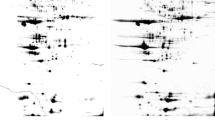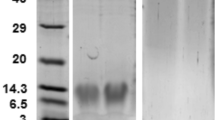Abstract
The current study investigated proteomic divergence in the hemolymph of early fourth instar larvae of Helicoverpa armigera fed with triflumuron (TFM) and a synergistic growth inhibitory combination of TFM and β-sitosterol (BS) in a 1:1 ratio. LC-MS analysis identified 65 proteins differentially downregulated in larvae fed with TFM and 75 in larvae fed with TFM + BS, essential for maintaining homeostasis and performing physiological and metabolic activities in H. armigera, when compared to untreated controls. In the TFM-fed larvae, deletions comprised 7 DNA processing, 11 RNA processing, 7 protein processing, 6 metabolic, 5 transport, 11 structural, 8 signal transduction, and 10 stress response proteins. TFM + BS-fed larvae showed relative deletions of 8 DNA processing, 14 RNA processing, 6 protein processing, 7 metabolic, 7 transport, 13 structural proteins, 7 signal transduction, and 12 stress response proteins. Both diets resulted in differential expression of 10 and 6 proteins, respectively, with TFM-fed larvae expressing proteins related to defense and detoxification, while TFM + BS-fed larvae expressing primarily upregulated proteins involved in sensory stimulus perception, particularly olfaction, along with one stress protein. Thus, analysis of the overall protein expression of the organism could provide an insight into important proteins suppressed and activated which can be future targets protein to control the pest population.


Similar content being viewed by others
References
Abdulwahab RA, Alaiya A, Shinwari Z, Allaith AA, Giha HA (2019) LCMS/MS proteomic analysis revealed novel associations of 37 proteins with T2DM and notable upregulation of immunoglobulins. Int J Mol Med 43:2118–2132
Barlan K, Gelfand VI (2017) Microtubule-based transport and distribution, tethering, and organization of organelles. Cold Spring Harb Perspect Biol 9(5):1–12
Boyer LA, Langer MR, Crowley KA, Tan S, Denu JM, Peterson CL (2002) Essential role for the Sant domain in the functioning of multiple chromatin remodeling enzymes. Mol Cell 10(4):935–942
Burgute BD, Peche VS, Steckelberg AL, Glöckner G, Gaben B, Gehring NH, Noegel AA (2014) NKAP is a novel RS-related protein that interacts with RNA and RNA binding proteins. Nucleic Acids Res 42(5):3177–3193
Campbell PM, Cao AT, Hines ER, East PD, Gordon KHJ (2008) Proteomic analysis of the peritrophic matrix from the gut of the caterpillar Helicoverpa armigera. Insect Biochem Mol Biol 38(9):950–958
Chen G, Liu H, Mo B-C, Hu J, Liu S-Q, Bustos-Segura C, Xue J, Wang X (2020) Growth and development of Helicoverpa armigera (Lepidoptera: Noctuidae) larvae Infected by Heliothis virescens ascovirus 3i (HvAV-3i). Front Physiol 11:93
Chen XL, Su L, Li BL, Li GW, Wu JX (2018) Molecular and functional characterization of three odorant binding proteins from the oriental fruit moth Grapholita molesta (Busck) (Lepidoptera: Tortricide). Arch Insect Biochem Physiol 98(2):1–12
Ciftci-Yilmaz S, Morsy MR, Song L, Coutu A, Krizek BA, Lewis MW, Mittler R (2007) The EAR-motif of the Cys2/His2-type zinc finger protein Zat7 plays a key role in the defense response of Arabidopsis to salinity. J Biol Chem 282:9260–9268
Craig DO, Jorge FC (2013) Economic and policy issues of U.S. agricultural pesticide use trends. Pest Manag Sci 69(9):1001–1025
Cunningham JP, Zalucki MP, West SA (1999) Learning in Helicoverpa armigera (Lepidoptera: Noctuidae): a new look at the behavior and control of a polyphagous pest. Bull Entomol Res 89(3):201–207
Cutler P (2003) Protein arrays: the current state-of-the-art. Proteomics 3:3–18
Dawkar VV, Chikate YR, Gupta VS, Slade SE, Giri AP (2011) Assimilatory potential of Helicoverpa armigera reared on host (Chickpea) and nonhost (Cassia tora) diets. J Proteome Res 10(11):5128–5138
Fica SM, Oubridge C, Wilkinson ME, Newman AJ, Nagai K (2019) A human postcatalytic spliceosome structure reveals essential roles of metazoan factors for exon ligation. Science 363:710–714
Florens L, Washburn MP (2006) Proteomic analysis by multidimensional protein identification technology. Methods Mol Biol 328:159–175
Geng ZC, Chang YP, Zhang B, An SH, Zhao WL (2023) Analysis of the functional mechanism of ATP synthase subunit α in the metamorphosis of Helicoverpa armigera (Lepidoptera: Noctuidae) larvae. Acta Entomol Sin 66(5):619–627
Gill HK, Garg H (2014) Pesticides: Environmental impacts and management strategies. In: Larramendy ML, Soloneski S (eds) Pesticides - Toxic Aspects. London, Intech Open, pp 2–3. https://doi.org/10.5772/57399
Hawkins NJ, Bass C, Dixon A, Neve P (2019) The evolutionary origins of pesticide resistance. Biol Rev 94:135–155
Ito K, Kidokoro K, Sakuma Y, Meshi T, Iwabuchi M, Shinozaki K, Kadono-Okuda K (2018) A single amino acid substitution in the Bombyx-specific mucin-like membrane protein causes resistance to Bombyx mori densovirus. Sci Rep 8:7430
Kadrmas JL, Smith MA, Clark KA, Pronovost SM, Muster N, Yates JR 3rd, Beckerle MC (2004) The integrin effector PINCH regulates JNK activity and epithelial migration in concert with Ras suppressor 1. J Cell Biol 167:1019–1024
Klose J, Nock C, Herrmann M, Stühler K, Marcus K, Blüggel M, Lehrach H (2002) Genetic analysis of the mouse brain proteome. Nat Genet 30:385–393
Kranthi KR, Jadhav DR, Kranthi S, Wanjari RR, Ali SS, Russell DA (2002) Insecticide resistance in five major insect pests of cotton in India. Crop Prot 21:449–460
Laity JH, Lee BM, Wright PE (2001) Zinc finger proteins: new insights into structural and functional diversity. Curr Opin Struct Biol 11:39–46
Li T, Chen L, Cheng J, Dai J, Huang Y, Zhang J, Xia Q (2016) SUMOylated NKAP is essential for chromosome alignment by anchoring CENP-E to kinetochores. Nat Commun 7:12969
Linck R, Fu X, Lin J, Ouch C, Schefter A, Steffen W, Nicastro D (2014) Insights into the structure and function of ciliary and flagellar doublet microtubules: tektins, Ca2+-binding proteins, and stable protofilaments. J Biol Chem 289:17427–17444
Lu YX, Xu WH (2010) Proteomic and phosphoproteomic analysis at diapause initiation in the cotton bollworm Helicoverpa armigera. J Proteome Res 9(10):5053–5064
Mazumdar M, Misteli T (2005) Chromokinesins: multitalented players in mitosis. Trends Cell Biol 15:349–355
Meng JY, Zhang CY, Lei CL (2010) A proteomic analysis of Helicoverpa armigera adults after exposure to UV light irradiation. J Insect Physiol 56:405–411
Mishra M, Gupta KK, Kumar S (2015) Impact of the stem extract of Thevetia neriifolia (Apocynaceae) on food consumption and growth of early fourth instars of Helicoverpa armigera. Malaya J Biosci 2(1):26–35
Mishra M, Sharma A, Dagar VS, Warikoo R, Kumar S (2023) Enhanced growth regulatory potential of triflumuron against Helicoverpa armigera early fourth instars when synergized with β-sitosterol. Available at SSRN: https://ssrn.com/abstract=4493771 or https://doi.org/10.2139/ssrn.4493771
Nishida E, Gotoh Y (1993) The MAP kinase cascade is essential for diverse signal transduction pathways. Trends Biochem Sci 18:128–131
Norrander JM, Perrone CA, Amos LA, Linck RW (1996) Structural comparison of tektins and evidence for their determination of complex spacings in flagellar microtubules. J Mol Biol 257:385–397
Ong SE, Blagoev B, Kratchmarova I, Kristensen DB, Steen H, Pandey A, Mann M (2002) Stable isotope labeling by amino acids in cell culture, SILAC, as a simple and accurate approach to expression proteomics. Mol Cell Proteom 1:376–386
Paramasiva I, Sharma HC, Krishnayya PV (2014) Antibiotics influence the toxicity of the delta endotoxins of Bacillus thuringiensis towards the cotton bollworm Helicoverpa Armigera. BMC Microb 14:201–211
Pauchet Y, Muck A, Svatoš A, Heckel DG, Preiss S (2008) Mapping the larval midgut lumen proteome of Helicoverpa armigera, a generalist herbivorous insect. J Proteome Res 7(4):1629–1639
Pinto BS, Wilmington SR, Hornick EE, Wallrath LL, Geyer PK (2008) Tissue-specific defects are caused by loss of the Drosophila MAN1 LEM domain protein. Genetics 180(1):133–145
Prudden J, Perry JJ, Arvai AS, Tainer JA, Boddy MN (2009) Molecular mimicry of SUMO promotes DNA repair. Nat Struct Mol Biol 16(5):509–516
Rhiannon M, Katrina AB, Elliott JS (2022) Uncovering protein function: from classification to complexes. Essays Biochem 66(3):255–285
Ross PL, Huang YN, Marchese JN, Williamson B, Parker K, Hattan S, Pappin DJ (2004) Multiplexed protein quantitation in Saccharomyces cerevisiae using amine-reactive isobaric tagging reagents. Mol Cell Proteom 3:1154–1169
Rust MK, Hemsarth WL (2019) Synergism of adulticides and insect growth regulators against larval cat fleas (Siphonaptera: Pulicidae). J Med Entomol 56(3):790–795
Sakamoto H, Maruyama K, Sakuma Y, Meshi T, Iwabuchi M, Shinozaki K, Yamaguchi-Shinozaki K (2004) Arabidopsis Cys2/His2-type zinc-finger proteins function as transcription repressors under drought, cold, and high-salinity stress conditions. Plant Physiol 136:2734–2746
Sambrook J, Russell DW (2006) SDS-polyacrylamide gel electrophoresis of proteins. CSH Protocols. https://doi.org/10.1101/pdb.prot4540
Schulz TC, Swistowska AM, Liu Y, Swistowski A, Palmarini G, Brimble SN, Zeng X (2007) A large-scale proteomic analysis of human embryonic stem cells. BMC Genomics 8:478
Stahl-Zeng J, Lange V, Ossola R, Eckhardt K, Krek W, Aebersold R, Domon B (2007) High sensitivity detection of plasma proteins by multiple reaction monitoring of N-glycosites. Mol Cell Proteom 6:1809–1817
Tellam RL, Eisemann C, Casu R, Pearson R (2000) The intrinsic peritrophic matrix protein peritrophin-95 from larvae of Lucilia Cuprina is synthesized in the cardia and regurgitated or excreted as a highly immunogenic protein. Insect Biochem Mol Biol 30:9–17
Vercauteren FG, Bergeron JJ, Vandesande F, Arckens L, Quirion R (2004) Proteomic approaches in brain research and neuropharmacology. Eur J Pharmacol 500:385–398
Walczak CE, Heald R (2008) Mechanisms of mitotic spindle assembly and function. Int Rev Cytol 265:111–158
Wang G, Liu PC, Wang JX, Zhao XF (2011) A BTB domain-containing gene is upregulated by immune challenge. Arch Insect Biochem Physiol 77:58–71
Wang H, Shi Y, Wang L, Liu S, Wu S, Yang Y, Wu Y (2018) CYP6AE gene cluster knockout in Helicoverpa armigera reveals role in detoxification of phytochemicals and insecticides. Nat Commun 9(1):4820
Wang P, Granados RR (1997) An intestinal mucin is the target substrate for a baculovirus enhancin. Proc Natl Acad Sci USA 94:6977–6698
Wolters DA, Washburn MP, Yates JR 3rd (2001) An automated multidimensional protein identification technology for shotgun proteomics. Anal Chem 73:5683–5690
Zhang Q, Lu YX, Xu WH (2011) Integrated proteomic and metabolomic analysis of larval brain associated with diapause induction and preparation in the cotton bollworm Helicoverpa armigera. J Proteome Res 11(2):1042–1053
Zhang X, Guo W (2011) Isolation and identification of insect intestinal mucin HaIIM86–the new target for Helicoverpa armigera biocontrol. Int J Biol Sci 7:286–296
Acknowledgements
The authors thank to the Principal, Acharya Narendra Dev College for providing the laboratory and culture facilities to conduct the experimental work.
Funding
The authors are grateful to the Council of Scientific and Industrial Research, New Delhi [Grant No. 13(9163-A)/2021-Pool] for providing the research fellowship to carry out the investigations.
Author information
Authors and Affiliations
Contributions
All the authors contributed to the study conception and design. Material preparation, experimentation and data collection were performed by Monika Mishra, Aarti Sharma and Vinay Singh Dagar. The results were critically analysed by Monika Mishra and Sarita Kumar. The first draft of the manuscript was written by Monika Mishra and all authors contributed to the editing of the manuscript. All authors read and approved the final manuscript.
Corresponding author
Ethics declarations
Ethical approval
This study did not require any ethical approval.
Conflict of interest
The authors report that there is no conflict of interest.
Additional information
Publisher’s Note
Springer Nature remains neutral with regard to jurisdictional claims in published maps and institutional affiliations.
Rights and permissions
Springer Nature or its licensor (e.g. a society or other partner) holds exclusive rights to this article under a publishing agreement with the author(s) or other rightsholder(s); author self-archiving of the accepted manuscript version of this article is solely governed by the terms of such publishing agreement and applicable law.
About this article
Cite this article
Mishra, M., Sharma, A., Dagar, V.S. et al. Protein divergence in Helicoverpa armigera hemolymph induced by the dietary triflumuron alone and in binary combination with β-sitosterol. Int J Trop Insect Sci (2024). https://doi.org/10.1007/s42690-024-01234-4
Received:
Accepted:
Published:
DOI: https://doi.org/10.1007/s42690-024-01234-4




